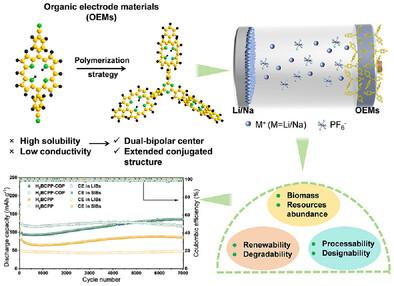双极共轭有机聚合物阴极实现超稳定的10000循环有机锂和钠电池
IF 12.1
2区 材料科学
Q1 CHEMISTRY, MULTIDISCIPLINARY
引用次数: 0
摘要
有机分子具有可设计的分子结构和可再生资源,是各种可充电电池的潜在电极材料;然而,它们的导电性差和在电解质中的高溶解度限制了它们的电化学性能。这些挑战可以通过构建共轭有机聚合物(cop)来解决。本文报道了用三嗪连接剂(H2BCPP‐COP)聚合5,15 -双(4 -氰苯基)卟啉(H2BCPP)的双双极中心COP,并评价了其作为锂电池和钠电池阴极的性能。与H2BCPP相比,两种体系中H2BCPP - COP的电化学性能都得到了显著提高,表现出高容量、出色的倍率性能和良好的循环稳定性。值得注意的是,在有机锂电池(olb)中,H2BCPP‐COP在10,000次循环中实现了121 mAh g−1的容量,在室温下2.0 a g−1的最大容量保持率为89%,同时在宽温度范围(- 20-50°C)内保持稳定运行。在有机钠电池(osb)中观察到更高的容量,突出了它们的多功能性。原位/非原位光谱分析和理论模拟表明,这种特殊的性能来自于高度稳定的COP骨架,以及卟啉和三嗪单元中阳离子和阴离子与双极性活性位点(C─N/C = N)的交替相互作用。本文章由计算机程序翻译,如有差异,请以英文原文为准。

Dual‐Bipolar Conjugated Organic Polymer Cathode Enabling Ultra‐Stable 10 000‐Cycle Organic Lithium and Sodium Batteries
Organic molecules are potential electrode materials for various rechargeable batteries owing to their designable molecular structures and renewable resources; however, their poor electronic conductivity and high solubility in electrolytes limit their electrochemical performance. These challenges can be addressed by constructing conjugated organic polymers (COPs). Herein, a dual‐bipolar centers COP is reported via polymerization of 5,15‐bis(4‐cyanophenyl) porphyrin (H2 BCPP) using triazine linker (H2 BCPP‐COP) and evaluate its performance as a cathode for both lithium and sodium batteries. The electrochemical performance of H2 BCPP‐COP is significantly improved compared with H2 BCPP in both systems, exhibiting high capacity, outstanding rate capability, and excellent cycling stability. Notably, in organic lithium batteries (OLBs), H2 BCPP‐COP achieves a capacity of 121 mAh g−1 over 10 000 cycles with 89% capacity retention of maximum capacity at 2.0 A g−1 at room temperature, while maintaining stable operation across a wide temperature range (−20–50 °C). Even higher capacities are observed in organic sodium batteries (OSBs), highlighting their versatility. In/ex situ spectroscopic analyses and theoretical simulations reveal that the exceptional performance arises from the highly stable COP backbone and the alternating interaction of cations and anions with the dual‐bipolar active sites (C─N/C═N) in the porphyrin and triazine units.
求助全文
通过发布文献求助,成功后即可免费获取论文全文。
去求助
来源期刊

Small
工程技术-材料科学:综合
CiteScore
17.70
自引率
3.80%
发文量
1830
审稿时长
2.1 months
期刊介绍:
Small serves as an exceptional platform for both experimental and theoretical studies in fundamental and applied interdisciplinary research at the nano- and microscale. The journal offers a compelling mix of peer-reviewed Research Articles, Reviews, Perspectives, and Comments.
With a remarkable 2022 Journal Impact Factor of 13.3 (Journal Citation Reports from Clarivate Analytics, 2023), Small remains among the top multidisciplinary journals, covering a wide range of topics at the interface of materials science, chemistry, physics, engineering, medicine, and biology.
Small's readership includes biochemists, biologists, biomedical scientists, chemists, engineers, information technologists, materials scientists, physicists, and theoreticians alike.
 求助内容:
求助内容: 应助结果提醒方式:
应助结果提醒方式:


